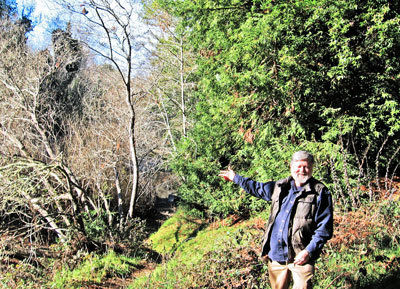
The Japanese call them Living Treasures — elders who have been officially designated as “holders of important intangible resources.” If our community gave such awards, Fred McPherson would certainly be a recipient.
McPherson has become a living repository for all that nature can teach us in the Santa Cruz Mountains, and he generously shares that knowledge with others.
McPherson will speak on “The Geology and Ecotones of Santa Cruz” at 10 a.m. Feb. 18 as part of the Connect with Nature Lecture Series at the Museum of Natural History, 1305 E. Cliff Drive, in Santa Cruz.
I recently joined Fred, my favorite natural history mentor, at Henry Cowell Redwoods State Park for a walk and talk about how our geology has formed the ecosystems we live in.
“An ecotone is a boundary where one ecosystem evolved with its own plants and animals and where it overlaps with another ecosystem,” he said. “You get a part of each ecosystem intertwining, so you get more diversity.”
He pointed to a demarcation point where the deciduous riparian trees — red willows, cottonwoods and sycamores — meet the edge of the redwoods.
The difference is in the soil. Along the river, the soil is alluvial, a mix of sand and earth deposited by the river. Up the slope to the sandstone and clay soil, the redwoods’ roots are surprisingly shallow, and they must intertwine with each other under the surface for support.
One of our favorite trees, the deciduous sycamore, lives in the riparian corridor of the San Lorenzo River. The mottled bark of soft grays and creams and the branches, clawing up to the weak sun, display an overlooked winter beauty. More than 160 feet tall, the trees were recently designated as among the tallest sycamore groves in the state.
“The Ben Lomond Mountain, the San Lorenzo Valley and the scenery to the east is all on the Pacific Plate,” McPherson said. “The San Andreas Fault line goes through Lexington Reservoir and behind the Forest of Nisene Marks State Park in Aptos. On the other side is the North American plate. The Pacific plate ends its land journey around Point Reyes and then goes out into the ocean up to Alaska.
“The North American plate is going south, and we’re going north. It’s called the Loma Prieta kink. It’s kind of kinked up here, and that’s what lifted these mountains 5 million years ago. We’re on the western side of the kink. It’s a dynamic story that most people don’t realize.”
McPherson holds that understanding geology is important to our everyday lives.
“Our geological formations are a valuable source of sand for making glass and aquifers for our water, and we need to know about the dynamics of the riparian corridor for our water supply — how much water you can take out of the river?” said McPherson, who serves on the board of the San Lorenzo Valley Water District.
The San Lorenzo Valley watershed is the last place where sycamores and white alders grow as you go up the coast, he noted.
“It’s a major transitional zone, and we’re just beginning to see the differences, but we don’t know why.” he said. “It may be because of the ancient geology of the Santa Cruz Mountains and the formation of the Monterey Bay and what happened during the Ice Age. There are a lot of mysteries.”
As we headed down to the San Lorenzo River, McPherson remembered a day when he and his wife, Roberta, were shooting a film down on the little beach behind the park gift shop.
“One time we were down here getting some good riparian shots when I saw these underwater things, which I thought were fish at first. First I saw little fish coming, little steelheads, a whole school coming like a torpedo, which we got on camera; then these underwater creatures coming, mergansers, chasing these fish.”
Mergansers are large ducks the size of mallards that dive underwater to catch swimming fish and insects.
“That was incredible, and that’s the kind of serendipity I just love. You’re shooting one thing in nature and another thing just comes along. The film is just full of stuff like that.”
McPherson’s film, “The Natural Wonders of Henry Cowell State Park,” was shot over a period of five years and showcases different ecosystems and how they were created there from a geological perspective.
The DVD is available at the Henry Cowell Gift Shop and the Boulder Creek Drug Store for $20. It will be shown at his lecture.
For information on the lecture series at the Natural History Museum, visit www.santacruzmuseums.org.
– Carol Carson, M.Ed., is a naturalist, writer, and educator.











